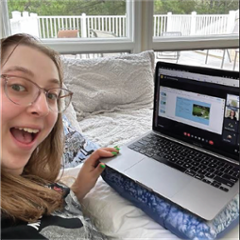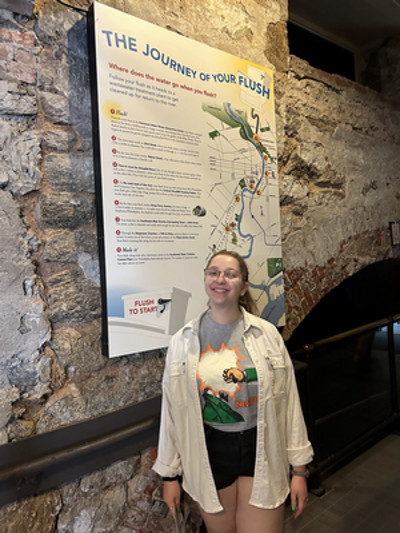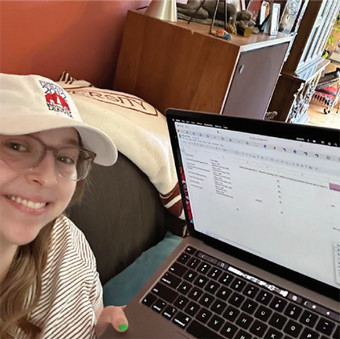ENVS Mentorship Program Spotlight: Andie Sheinbaum
Andie Sheinbaum is completing the Environmental Studies summer 2023 mentorship program with Charles River Watershed Association (CRWA). CRWA's mission is to protect, restore and enhance the Charles River and its watershed through science, advocacy and the law. Get to know Andie and hear about her experiences over the summer.
About Andie
Andie is a rising senior at Brandeis, majoring in environmental studies with minors in legal studies and English. She is originally from Aurora, Colorado, where she graduated from Smoky Hill High School. She is passionate about a wide variety of extracurricular activities, including mock trial, improv, WBRS radio, admissions and orientation. In her spare time, she loves to read, hike and go to concerts. Her favorite piece of environmental legislation is the Clean Water Act.
Part I: Getting Started with Charles River Watershed Association
 Andie attended and presented research during CRWA's meeting on plans to reduce combined sewer overflows (CSOs). CSOs happen when, due to old infrastructure, sewage and stormwater are handled in the same pipes. When there is a big storm, sewage can end up washing into the river, which is what CRWA is working on preventing!
Andie attended and presented research during CRWA's meeting on plans to reduce combined sewer overflows (CSOs). CSOs happen when, due to old infrastructure, sewage and stormwater are handled in the same pipes. When there is a big storm, sewage can end up washing into the river, which is what CRWA is working on preventing!
Part II: Making an Impact at Charles River Watershed Association
Andie's first month at Charle River Watershed Association has been impactful! She shared the following with Brandeis Environmental Studies:
"In the past few weeks, I have begun to compile my research into a report on the Combined Sewer Overflow (CSO) reduction strategies of various peer cities. I have been able to synthesize some of my findings, such as by realizing that downspout disconnection, tunnel storage, and privately-held green infrastructure are used by a variety of cities, and are extremely helpful (and relatively easy) ways to reduce CSOs. One of the highlights of my work recently was that my supervisor, Max Rome, had a meeting with EPA and Massachusetts Water Resources Authority (MWRA), and discussed my research with them. EPA and MWRA have disputed the use of green stormwater infrastructure (GSI) in the past, but Max was able to bring up downspout disconnection and tunnel storage, and both agencies said they hadn’t really considered these strategies before.
One of the highlights of my work recently was that my supervisor, Max Rome, had a meeting with EPA and Massachusetts Water Resources Authority (MWRA), and discussed my research with them. EPA and MWRA have disputed the use of green stormwater infrastructure (GSI) in the past, but Max was able to bring up downspout disconnection and tunnel storage, and both agencies said they hadn’t really considered these strategies before.
Another success that I enjoyed was being able to understand the language of the various reports and sundry documents that contain the information I need. At the beginning of my internship, I really had trouble breaking down the Long-Term Control Plans (LTCPs) and Long-Term Control Plan Updates (LTCPUs), and it took me a long time to find any relevant information. Now, having researched ten peer cities, I can find the exact numbers I need with efficiency and skill. For example, I’ve had issues in the past finding the exact number of impervious acres in a certain area. Now, I know to look for Green Acres (GAs) instead of just scale measurements, and get the most accurate numbers possible.
One of the biggest challenges that I’ve been facing is finding reliable and recent information. Many LTCPs are from twenty or thirty years ago, and the LTCPUs are often not as specific about what goals have been reached and the exact numbers I need to do adequate research. I have been able to overcome this problem by looking at outside sources, such as news articles or updates from watershed associations in the area.
An additional wrinkle, however, is that the water companies often seem to overrepresent the effectiveness of their GSI and stormwater plan. This makes sense, as the water companies are trying to prove their effectiveness to their shareholders and the public. That said, I have found numerous sources confirming EPA’s and MWRA’s position that GSI is not as effective as planned, in addition to being more expensive than gray infrastructure. This has been an interesting challenge for me to overcome because I obviously want to advocate for more GSI, but I don’t want to misrepresent the research. I have been able to overcome this challenge by incorporating a discussion section into my report. This way, I can advocate for additional GSI in Boston, but still discuss the complexity of the research.
I feel really proud of the work I have done so far. I have been able to communicate ideas that have actually helped the Charles River Watershed Association (CRWA) in their advocacy work, and I am working towards making a final report that will be distributed to the public and engineers alike. This will allow people to realize the impacts of GSI, and hopefully incorporate it in Boston."
Part III: Final Accomplishments with Charles River Watershed Association
 Andie shared her final reflections with Environmental Studies from her mentorship this summer.
Andie shared her final reflections with Environmental Studies from her mentorship this summer.
"Now that I’ve finished my internship, I’m feeling extremely proud of all that I’ve accomplished! One of my greatest successes has been learning all of the jargon involved in Combined Sewer Overflows (CSOs), from Long-Term Control Plans (LTCPs) to Green Acres (GA) to Billion Gallons per Year (BGY). Now that I am familiar with the lexicon of CSO terms, my research has been made much easier and my arguments stronger. At the beginning of the summer, when I was researching Kansas City, I had a lot of trouble parsing documents and what would be helpful. I recorded information about the size of each Green Stormwater Infrastructure (GSI) project, rather than the acres of impervious surfaces the project drained. By the end of my internship, I was deeply familiar with the ins and outs of CSOs. For example, when I was researching the final city for my report, Washington, D.C., I was able to comprehend the different ways their tunnel storage and GSI played together, and how much CSO each sequestered.
One challenge I had in the final weeks of my internship was finding specific information needed in my report. For example, one city may have great information about the number of CSO outfalls currently in operation, but no information as to actual number of gallons of CSO that each event was causing. Another city might have no details about the former, but plenty about the latter. I believe that much of this is because cities are trying to make themselves look good; these Long-Term Control Plan Updates (LTCPUs) exist in order to advertise to constituents and the federal/state/city government how much progress has been made in pursuit of CSO reduction. If one city has eliminated many CSO drains, but many BGY are still draining into the rivers, they may be less inclined to include the latter information in favor of highlighting the former. As such, many specific numbers are hidden. I wasn’t quite able to overcome this challenge before the end of the summer with the time constraints I was under, but I hope to be able to solve this issue while researching for my thesis this fall. I plan to contact the project managers for each city’s CSO LTCP, so that I can get hard reports and data directly from the source.
As I look toward the fall and my continued research into infrastructure for my thesis, I am feeling greatly inspired by my CSO research. I think that the low-hanging fruit aspect of GSI (in that it is relatively inexpensive, provides lots of co-benefits [Philadelphia estimates that its CSO plan will pay for itself within 25 years due to its co-benefits alone], and returns the world to a less-human influenced state) is incredibly important for cities all over the globe. I think that GSI will make cities healthier, prettier, and more accessible. This is the definition of multi-solving, which is my favorite part of ENVS in the first place. I think GSI truly is the future of stormwater infrastructure, and I look forward to getting to research it more."